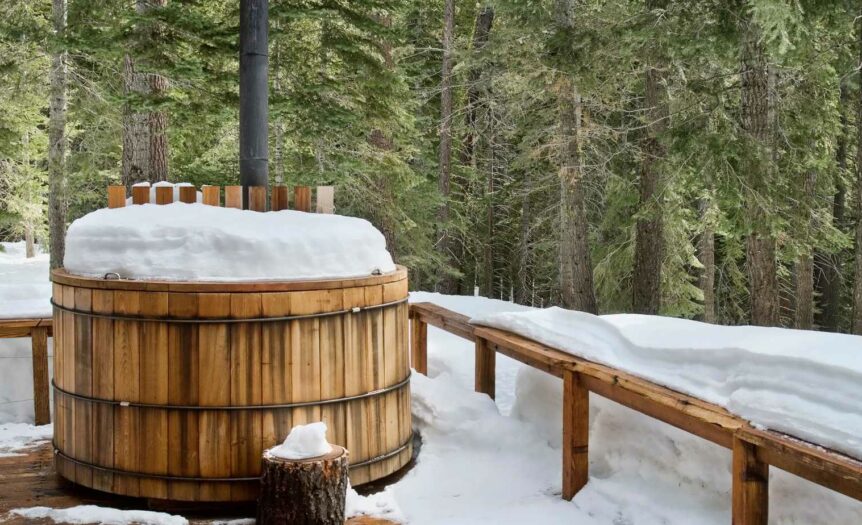As the temperature drops, winterizing your hot tub becomes a crucial task for ensuring its optimal performance and longevity. With freezing temperatures posing risks such as ice formation in pipes and potential damage to components, proper winterization is essential for keeping your hot tub safe and ready to use throughout the year.
Not only does it protect your investment, but it also saves you time and money on costly repairs while maintaining a delightful spa experience.
Steps To Winterize A Hot Tub
To winterize a hot tub, first, turn off the power and drain all the water from it using a wet-dry vacuum or gravity-fed system, then clean and dry the hot tub thoroughly to prevent mold growth.
Drain The Water
One essential step to winterize your hot tub is draining the water completely. By doing this, you eliminate any risk of water freezing inside the pipes and causing damage during colder months.
First, locate the main drain valve and make sure it’s accessible.
To begin draining, connect a garden hose to the drain spigot or use a submersible pump for faster results. Position the other end of the hose in a safe place where water can flow away without causing problems such as flooding your lawn or damaging structures on your property.
As you’re emptying out your spa, take some time to inspect its interior for signs of damage or wear that might need attention before using it again next season. Once all water has been removed from your hot tub, remember to properly close and secure any valves or pumps involved in the process so nothing gets damaged due to exposure during winter months.
Clean And Dry The Hot Tub
The next step in winterizing your hot tub is to clean and dry it thoroughly. This ensures that no dirt, grime or debris remains stuck to the surface of the tub, which can cause long-term damage if left unchecked.
You should start by removing any visible debris from inside the tub with a net or skimmer attachment, followed by using an appropriate cleaning chemical recommended for your brand of hot tub.
Finally, ensure that all jets are fully dried as water left inside could freeze and cause damage during cold temperatures. In addition to this, consider using an insulating cover which can help retain heat and prevent snow build-up on top of the spa.
Protect The Hot Tub Cover
To keep your hot tub cover in good condition during the winter, it’s crucial to take a few extra precautions. One of the easiest ways to protect your cover is by investing in a proper cover cap or shield.
In addition to using a protective covering, you can also use tie-down straps or locks to secure the cover in place. This will prevent wind from lifting up the cover and exposing your hot tub to cold air and debris.
It’s also important not to stack heavy items on top of the hot tub cover, as this could cause damage or deformation over time.
Tips For Easy Hot Tub Winterization
To make winterizing your hot tub a breeze, consider using non-toxic antifreeze instead of completely draining the system, store accessories in a dry and safe place, and always follow the manufacturer’s instructions for optimal results.
Use Non-toxic Antifreeze
I highly recommend using non-toxic antifreeze when winterizing your hot tub.
To use non-toxic antifreeze, start by draining all the water from your hot tub. Then add the appropriate amount of antifreeze according to your hot tub’s owner’s manual.
Using non-toxic antifreeze will ensure that any remaining water in your hot tub won’t freeze and cause damage during cold temperatures.
Store Accessories Safely
I know from experience that it’s easy to forget about the smaller details when winterizing a hot tub, like where to store accessories. However, it is important to take care of them properly so they don’t get damaged or lost during the off-season.
My go-to solution is keeping all my hot tub accessories, such as pillows and thermometers, in an airtight storage container.
Another tip I learned through trial and error is to label everything with waterproof tags or tape so that you can quickly locate each item when opening your hot tub for the season.
Additionally, if your spa cover gets heavy snowfall on top of it throughout the winter months, be sure not to stack anything heavy on top of it inside your storage area.
By taking extra precautions when storing your hot tub accessories this winter, you’ll ensure that they remain in great condition for extended use once summer comes around again!
Follow Manufacturer’s Instructions
It is essential to follow the manufacturer’s instructions when winterizing your hot tub. This ensures that you are taking the necessary steps to protect your hot tub and prevent any damage that may occur during the winter season.
For example, Royal Spa recommends removing all of the water from the spa and then blowing out any remaining droplets with a wet-dry vacuum to ensure that no water remains in the plumbing lines.
They also suggest using non-toxic antifreeze specifically designed for use in hot tubs if you live in an area where temperatures drop below freezing consistently.
Conclusion: Enjoy Your Hot Tub Year-Round With Proper Winterization
With winter just around the corner, it’s essential to start thinking about hot tub maintenance. Winterizing your hot tub is crucial if you want to keep it in excellent condition year-round.
By following these simple steps, draining and cleaning your spa will be a breeze, and you’ll be able to protect it from the harsh cold weather. Use non-toxic antifreeze to keep things running smoothly, store accessories safely, and ensure that you follow the manufacturer’s instructions for optimal performance.
Related Posts:
How many Gallons in a Hot tub?
What’s the difference between a jacuzzi and a hot tub?
What is the Ideal Hot Tub Temperature?
How Long Does A Hot Tub Take To Heat Up?
How much is an Inflatable Hot tub?








